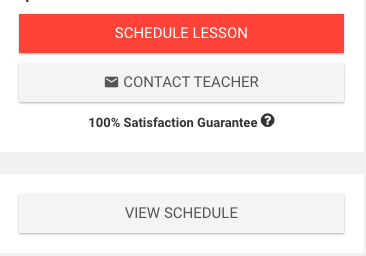A day or so ago, I had my second lesson with my online tutor from italki.
I was really looking forward to it for two reasons. Firstly because of the the success of the first one. And secondly because of the advances I felt I made in such a short space of time.
It is so easy to set up an appointment with your tutor once you have established a relationship with them.
All I had to do was choose “schedule lesson” and then follow the easy instructions.
Pre-Lesson Prep Is Key
The most important thing I realised I needed to make sure I’d done before I had a second lesson though was this:
I needed to make sure I have processed and captured the things I learnt from the previous one.
I am using the Anki Flash Card system to create flash cards for new vocabulary and now for grammar too.
Before I booked this second session, I made sure I had gone through my notes and completed my Flash Card generation.
Now this might seem a lot of work to some, but there are a number of benefits.
The main one though is this:
Once the flash cards have been generated, that is the bulk of the work done. All I need to do now is to keep reviewing them UNTIL I have embedded the knowledge.
It does take a bit of time to do the cards. Occasionally life takes over and sometimes it might take you a few days before you have reviewed the lesson.
But that is ok for a number of reasons:
– Because I have used Skype and have recorded the call, I can always go back and relive the lesson again
– The iTalki system is flexible. I can book a tutor for a session at a time and frequency convenient to me. This means I can go at my own pace and not be rushed by someone else’s agenda.
Gather Your Questions Before The Lesson
Another thing I realised I needed to have done before the lesson, was to gather any questions I had. It seemed to make sense to clear up any doubts or uncertainty straight away.
I had four questions I wanted to ask her:
– The first was related to the phrases grabarla (meaning “record it) and repetirlo (meaning “repeat it”). My question was about whether the “la” or “lo” in each case were gender specific – i.e. Could you have grabarlo and repetirla?
– The second question I had was about a useful phrase she had used that I had missed when capturing them. It was about how to let someone know it was ok to us the informal “tú” form of “you” rather than the more formal “usted”.
– The third question was about the very first phrase we covered last time. It was “Nosotros vivimos en el planeta tierra”. I wanted to know whether we could drop the “nosotros” (we) because the conjugation of vivir (to live) in this context (“vivimos”) indicates it is “we” who late doing the living.
– And finally I had a question about the speed at which Spanish people speak and whether words are “merged” deliberately. I had been watching an episode of Sevir y Proteger with subtitles and there appeared to be a difference between what was written and what was said… CONFUSING!
It’s Important To Know What You Want
And finally another really vital thing I needed to get clear about was what I wanted to get out of the lesson.
In my first lesson, we had walked through the Gabe Wyner’s excellent 625 word list and created sentences for each word.
In the long run that is what I will continue to do with each lesson.
But this time I wanted to try something out.
I have probably mentioned more than a few times now that “aprendo bailar salsa” – I am learning to dance salsa.
One of the tracks used in the class is Despacito by Luis Fonsi featuring Daddy Yankee. Justin Bieber has just done a cover version/remix of it.
But I prefer the original because it is entirely in Spanish. JB, sings away in English for the most part and then throws in a little Spanish.
Anyway, I LOOOVVVVVE the song and can’t stop playing it.
If for some reason the video won’t play, here’s the YouTube Link.
And here is a link To The Lyrics.
So I thought I would ask my tutor to talk me through each line of the lyrics.
If we are going to examine sentences why not make it the lyrics to a song that I am already listening to at least 5 times a day.
Learning Songs Helps Language Learning
I know this will help me become more proficient at Spanish. This is because the combination of the lyrics (left brain) and the music (right brain) will help me learn it faster.
I can also remember meeting a client in Kuwait a few years ago who spoke perfect English but had never been to either the UK or the States. She told me that the biggest help in learning my language was listening to and singing along to songs by English speaking artists.
That tip always stuck with me even though it was 15 or so years ago.
So Despacito it was then for the second lesson!
When I presented the idea to her, my tutor was more than happy.
It seems that some tutors on italki [LINK] like to teach their own curriculum and won’t go off piste. Others however are more than happy to adapt what they do to your needs.
Fortunately I had found the latter and as long as I didn’t insist she sing it, she was more than happy to explain Despacito to me.
I couldn’t wait to get through the questions and start understanding what those evocative lyrics were saying.
I Got The Answers To My Questions
If you are interested, the answers to the questions I asked (see above) were:
– Yes
– Por favor, tutéame
– Yes
– Sometimes Spanish people will shorten words e.g. Para sometimes becomes ‘pa’. Another thing to consider is that the text of the subtitles may not precisely correlate to the script the actors us.
And then it was on to Despacito.
I had managed to track down a coy of the lyrics and had sent them over to her.
There were two questions I had to make sure it was a suitable exercise to further my Spanish speaking ability:
– Can I benefit from learning the vocabulary and grammar from these lyrics given that the song originates from Latin America?
– Is there enough “proper” Spanish to learn from (once we get past the “Diridiri, dirididi Daddy” in the intro? I know many popular songs in English often use slang and I couldn’t imagine teaching anyone proper English from some hit songs (“My hump, my hump, my hump (ha), my lovely lady lumps (Check it out)”….Black Eyed Peas “My Humps”)
Fortunately, the answers to both these questions was a resounding “Sí”.
And so that is what we did.
Here’s How We Analysed The Song
We took a line of the song and then explored it in some depth.
For example, the first line of the song is this:
Sí, sabes que ya llevo un rato mirándote.
From that we pulled out the following learning points, some of which I’d covered elsewhere but I have left in for completeness:
Sí = Yes,
Saber = to know (or to taste)
Tu sabes que = you know that
Ya = already
llevo = to bring, to take, to carry
Llevo un rato – I have been spending some time….
Mirándote – I am watching you
mirar – to watch
Un rato – for a while
What worked really well was for me to try and work out what it meant first. Then my tutor helped me with what I didn’t know. She also corrected things I had’t got quite right.
So I knew that sabes was a conjugation of saber. I also knew that llevo meant carry.
What I didn’t spot was that mirándote was a conjugation of mirar. I also didn’t know what ya or un ratio meant.
So the actual translation is:
Yes, you know that I have been watching you for a while.
I must say it sounds better in Spanish!
And then we repeated that for another 7 lines. Which means by my reckoning, we’ve got the first two verses in the bag.
As Great As It Was… I Think It Was A Step Too Far
This time the session was much harder because there was so much more to discover. Last week my tutor used fairly simple sentences. These lyrics were far more complicated.
But even though it was a great lesson for me, I think I probably overstretched myself using these lyrics.
When I started creating my flash cards as I reviewed the content, things started to drop into place. However, next time I think we will go back to focussing on the word list.
Though this time it was harder to create the audios because Gabe Wyner’s Tutoring App wasn’t working for our lesson.
We might perhaps do one line of Despacito a lesson, but the focus will definitely be on the relatively easier stuff for now.
I still want to be able to sing along with the song in Spanish. So far I have at least one line nailed. I know this approach works for those learning English so I am going to persist with this for me.
If you have a Spanish song you can recommend, let me know in the comments box below.








Leave A Response